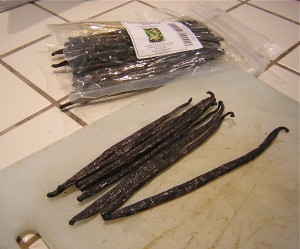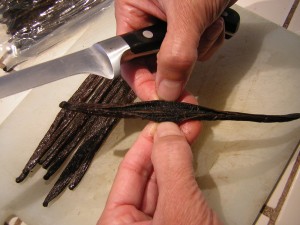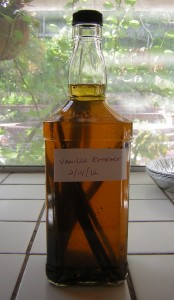Vanilla extract is a staple ingredient in our kitchen. I use it in everything from pies to cakes to yogurts and drinks (iced frapuccino anyone?). Since we use it so much, I started to notice how costly vanilla extract was. So, I’ve decided to do some research on growing vanilla, the different varieties available and how the extract is made.
The Flat-Leaved Vanilla (v. panifolia) has its origin in Mexico and Central America. It was cultivated by the pre-Columbian Mesoamerican people and introduced to Europe by the Spanish conquistador Hernan Cortes (wikipedia). Efforts to mass cultivate it outside of Mexico and Central America failed because it was found that it only flowered and produced the vanilla pods with pollination by the indigenous Melipona bee. Then, in 1841 it was discovered that the plant could be hand pollinated which lead to the global cultivation.
All vanilla plants originated from Mexico and Central America but their denomination changes based on the area in which they are cultivated. The major varieties of vanilla bean available in the market are Mexican, Bourbon and Tahitian beans. Vanilla pods produced in Mexico are called Mexican vanilla beans. When this same stock (v. panifolia) is grown in Madagascar or Indonesia, they are known as Bourbon or Madagascar vanilla beans. Tahitian beans are (obviously) grown in Tahiti and although they are believed to be a local developed stock they also have their origins in Mexico and Central America.
Regional heat, temperature, rain and other environmental pressures have a great impact on the taste and texture of the pods produced. Bourbon vanilla for example are long and slender with a very rich taste and aroma. They are oily and contain a lot of seeds. Mexican beans are similar to Bourbon but milder in taste with a spicy and woody character. In contrast, Tahitian beans are fruity and floral, shorter and fatter with the highest oil and water content and fewer seeds.
To make your own vanilla extract, you will need the following:
1. 10 Vanilla beans – choose whichever variety you like. You can also try different ones so you can compare and contrast the subtle nuances between them.
2. Alcohol (vodka, rum or bourbon are the most commonly used)
3. A glass container with a sealed top – I used an empty bottle of Jack Daniels.
4. A paring knife
5. A small cutting board
6. A funnel
Vanilla beans are sold by a single pod, in groups of 10 or 20, and by the pound (1/4 lb, 1/2 lb and 1 lb). Obviously, the price per pod decreases as volume increases and vice versa. I purchased 1/2 lb of Bourbon vanilla on Amazon for $25 dollars with free shipping. It came in a vacuum sealed package with 64 beans which comes out to .39 cents per pod. This is a significant saving considering they usually sell singly at the local store for $1.50 to $2.50 per pod. Make sure that your beans are nice and plump, not dried up and brittle.
For the alcohol, I used vodka but you can experiment with anything you like such as rum or bourbon. I bought the biggest, cheapest bottle of vodka I found.
With a sharp paring knife slice the vanilla pod through the middle to expose the seeds.
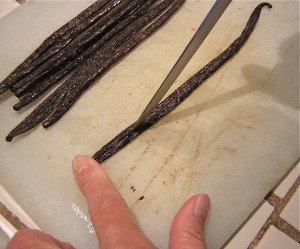 |
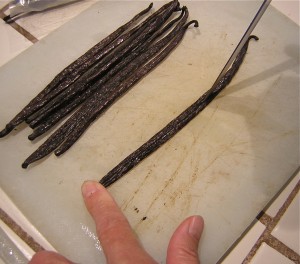 |
Scrape the seeds off on both sides of the pod. Make sure to scrape as much of the seeds as possible to increase the exposure to the alcohol and infuse it with flavor.
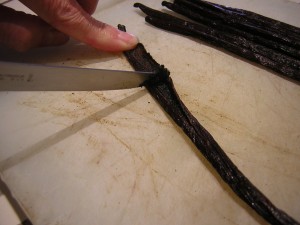 |
 |
Place the seeds into your glass container.
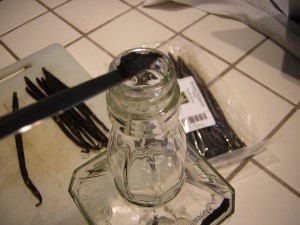 |
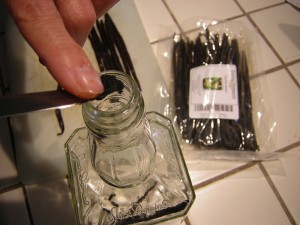 |
Add the scraped pod into the glass container as well. The pod has a lot of flavor (if not more) than the seeds and it will help intensify your extract.
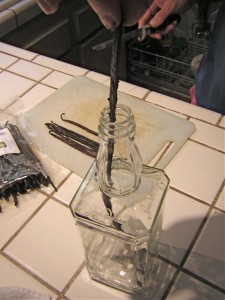
Repeat the above steps for all 10 vanilla beans. Fill the glass container with the alcohol of choice (vodka).
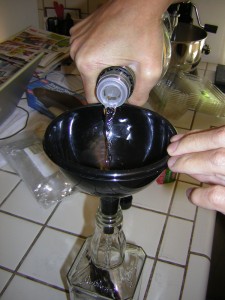 |
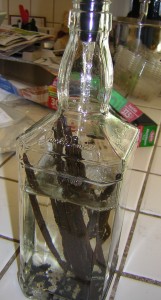 |
Shake it well and label it with the content and date.
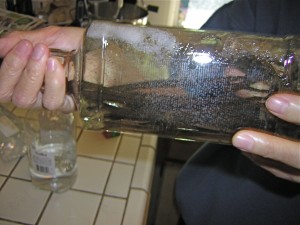 |
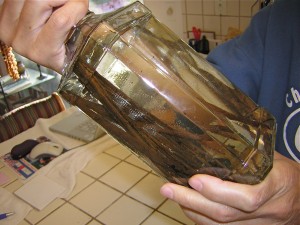 |
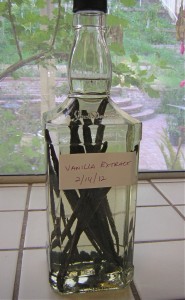
Place it in a covered dark spot (cupboard) and shake it once a day for a week. After a week, shake it once or twice a week for about 6 weeks. At that point you can start using it but the longer you allow it to infuse the stronger it will taste, 6 months or older being the optimal time. This is a picture of the infusion after the second day.
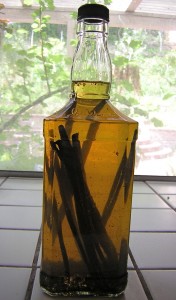
You can add more alcohol to the infusion as you draw the liquid down, reusing the vanilla beans. The vanilla beans will last for about 3 years or so. Happy brewing!
Update 2/17/12 (4 days later): I forgot to shake the bottle yesterday (out of sight out of mind…) but thought about it today. Gave it a nice shake and couldn’t resist checking it out. I was amazed with how deep the color had gotten and it had this INCREDIBLE vanilla smell to it. Already! I would have never guessed that it would infuse it so quickly. Can’t even imagine what it will be like in 6 months! I’ll do another update in a month and report on it’s progress. Here’s a picture of it.
